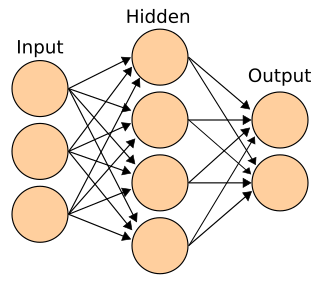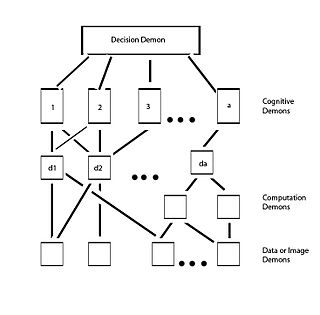Related Research Articles

In mathematics and computer science, an algorithm is a finite sequence of rigorous instructions, typically used to solve a class of specific problems or to perform a computation. Algorithms are used as specifications for performing calculations and data processing. More advanced algorithms can use conditionals to divert the code execution through various routes and deduce valid inferences, achieving automation eventually. Using human characteristics as descriptors of machines in metaphorical ways was already practiced by Alan Turing with terms such as "memory", "search" and "stimulus".
Artificial intelligence (AI) is intelligence—perceiving, synthesizing, and inferring information—demonstrated by machines, as opposed to intelligence displayed by non-human animals and humans. Example tasks in which this is done include speech recognition, computer vision, translation between (natural) languages, as well as other mappings of inputs. The Oxford English Dictionary of Oxford University Press defines artificial intelligence as:
the theory and development of computer systems able to perform tasks that normally require human intelligence, such as visual perception, speech recognition, decision-making, and translation between languages.

Marvin Lee Minsky was an American cognitive and computer scientist concerned largely with research of artificial intelligence (AI), co-founder of the Massachusetts Institute of Technology's AI laboratory, and author of several texts concerning AI and philosophy.

Creativity is a phenomenon whereby something new and valuable is formed. The created item may be intangible or a physical object.

Connectionism refers to both an approach in the field of cognitive science that hopes to explain mental phenomena using artificial neural networks (ANN) and to a wide range of techniques and algorithms using ANNs in the context of artificial intelligence to build more intelligent machines. Connectionism presents a cognitive theory based on simultaneously occurring, distributed signal activity via connections that can be represented numerically, where learning occurs by modifying connection strengths based on experience.
The Society of Mind is both the title of a 1986 book and the name of a theory of natural intelligence as written and developed by Marvin Minsky.
A mental image is an experience that, on most occasions, significantly resembles the experience of 'perceiving' some object, event, or scene, but occurs when the relevant object, event, or scene is not actually present to the senses. There are sometimes episodes, particularly on falling asleep and waking up, when the mental imagery may be dynamic, phantasmagoric and involuntary in character, repeatedly presenting identifiable objects or actions, spilling over from waking events, or defying perception, presenting a kaleidoscopic field, in which no distinct object can be discerned. Mental imagery can sometimes produce the same effects as would be produced by the behavior or experience imagined.
Soar is a cognitive architecture, originally created by John Laird, Allen Newell, and Paul Rosenbloom at Carnegie Mellon University. It is now maintained and developed by John Laird's research group at the University of Michigan.
Situated cognition is a theory that posits that knowing is inseparable from doing by arguing that all knowledge is situated in activity bound to social, cultural and physical contexts.
In psychology and cognitive science, a schema describes a pattern of thought or behavior that organizes categories of information and the relationships among them. It can also be described as a mental structure of preconceived ideas, a framework representing some aspect of the world, or a system of organizing and perceiving new information, such as a mental schema or conceptual model. Schemata influence attention and the absorption of new knowledge: people are more likely to notice things that fit into their schema, while re-interpreting contradictions to the schema as exceptions or distorting them to fit. Schemata have a tendency to remain unchanged, even in the face of contradictory information. Schemata can help in understanding the world and the rapidly changing environment. People can organize new perceptions into schemata quickly as most situations do not require complex thought when using schema, since automatic thought is all that is required.

Problem solving is the process of achieving a goal by overcoming obstacles, a frequent part of most activities. Problems in need of solutions range from simple personal tasks to complex issues in business and technical fields. The former is an example of simple problem solving (SPS) addressing one issue, whereas the latter is complex problem solving (CPS) with multiple interrelated obstacles. Another classification is into well-defined problems with specific obstacles and goals, and ill-defined problems in which the current situation is troublesome but it is not clear what kind of resolution to aim for. Similarly, one may distinguish formal or fact-based problems requiring psychometric intelligence, versus socio-emotional problems which depend on the changeable emotions of individuals or groups, such as tactful behavior, fashion, or gift choices.
A physical symbol system takes physical patterns (symbols), combining them into structures (expressions) and manipulating them to produce new expressions.

The history of artificial intelligence (AI) began in antiquity, with myths, stories and rumors of artificial beings endowed with intelligence or consciousness by master craftsmen. The seeds of modern AI were planted by philosophers who attempted to describe the process of human thinking as the mechanical manipulation of symbols.This work culminated in the invention of the programmable digital computer in the 1940s, a machine based on the abstract essence of mathematical reasoning. This device and the ideas behind it inspired a handful of scientists to begin seriously discussing the possibility of building an electronic brain.

The following outline is provided as an overview of and topical guide to thought (thinking):

Pandemonium architecture is a theory in cognitive science that describes how visual images are processed by the brain. It has applications in artificial intelligence and pattern recognition. The theory was developed by the artificial intelligence pioneer Oliver Selfridge in 1959. It describes the process of object recognition as a hierarchical system of detection and association by a metaphorical set of "demons" sending signals to each other. This model is now recognized as the basis of visual perception in cognitive science.
Psi-theory, developed by Dietrich Dörner at the University of Bamberg, is a systemic psychological theory covering human action regulation, intention selection and emotion. It models the human mind as an information processing agent, controlled by a set of basic physiological, social and cognitive drives. Perceptual and cognitive processing are directed and modulated by these drives, which allow the autonomous establishment and pursuit of goals in an open environment.
Perceptrons: an introduction to computational geometry is a book written by Marvin Minsky and Seymour Papert and published in 1969. An edition with handwritten corrections and additions was released in the early 1970s. An expanded edition was further published in 1987, containing a chapter dedicated to counter the criticisms made of it in the 1980s.

The eureka effect refers to the common human experience of suddenly understanding a previously incomprehensible problem or concept. Some research describes the Aha! effect as a memory advantage, but conflicting results exist as to where exactly it occurs in the brain, and it is difficult to predict under what circumstances one can predict an Aha! moment.

Neo-Piagetian theories of cognitive development criticize and build upon Jean Piaget's theory of cognitive development.
A semantic decomposition is an algorithm that breaks down the meanings of phrases or concepts into less complex concepts. The result of a semantic decomposition is a representation of meaning. This representation can be used for tasks, such as those related to artificial intelligence or machine learning. Semantic decomposition is common in natural language processing applications.
References
- Minsky, Marvin; The Society of Mind ISBN 0-671-65713-5 March 15, 1998.
- Minsky, Marvin; Papert, Seymour; Perceptrons: An Introduction to Computational Geometry ISBN 0-262-63111-3 December 28, 1987.